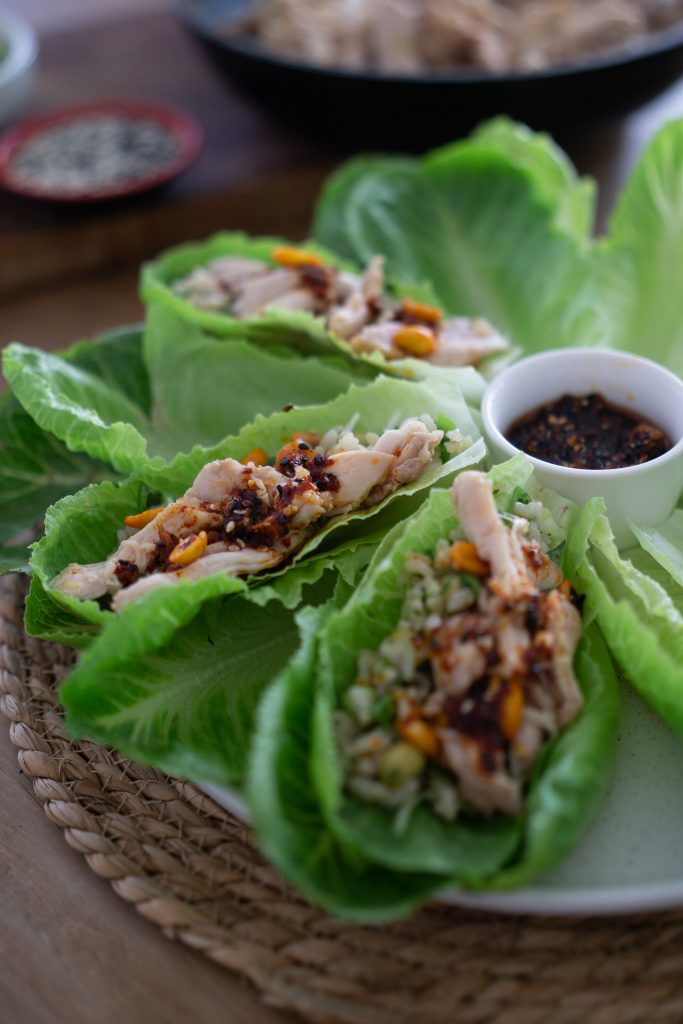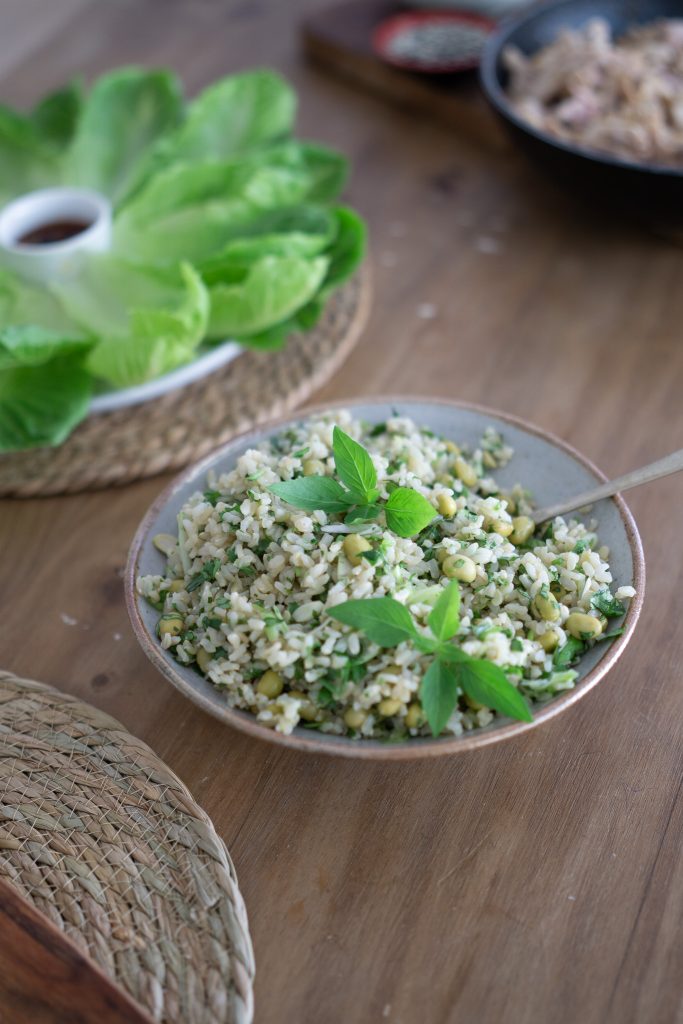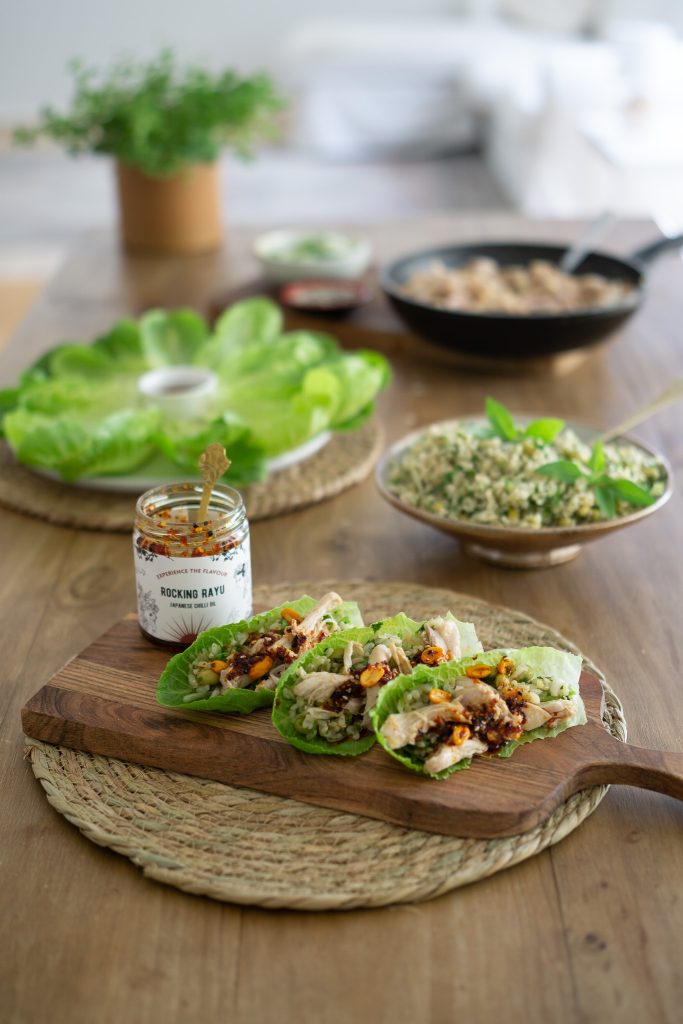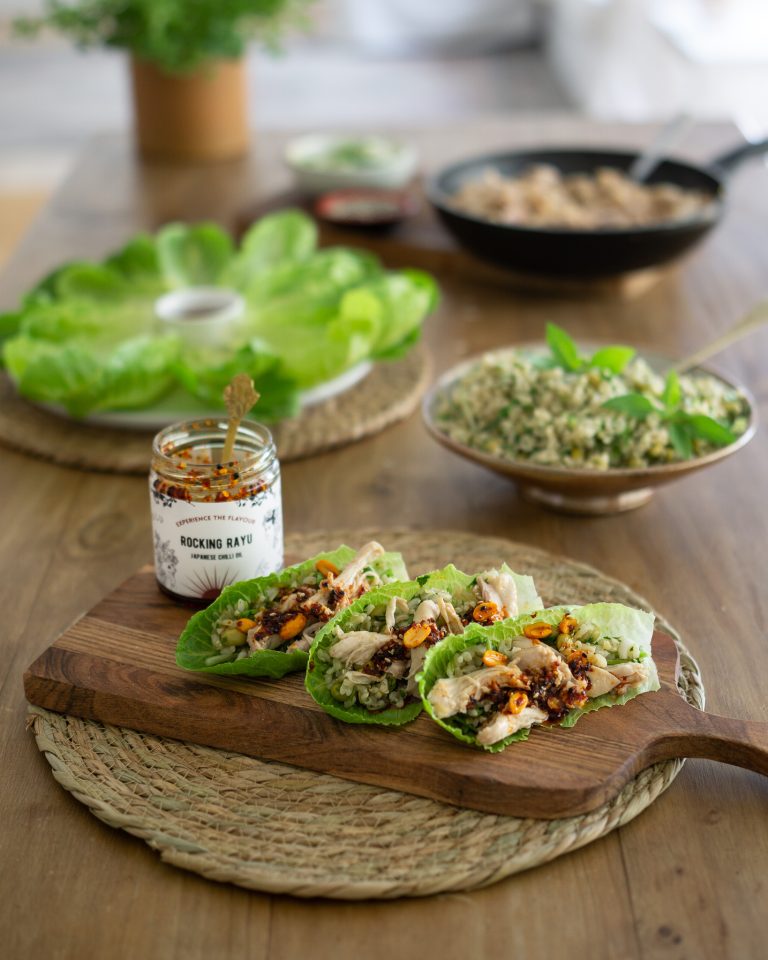If you’re like me, you’ve probably made lettuce cups a thousand times. They are so simple and quick to make, they pack a good punch of protein and are generally an absolute crowd-pleaser. Before finding this variation however, I’d yet to venture into the world of chicken in a lettuce cup let alone a marinade poached variety that brings an extra layer of flavour to the party in your mouth. Now that I’ve tried it, I’m a pretty big fan, and not only am I going to be making these on repeat, I’m also going to be experimenting with this technique all over the place, look out tacos, you’re in for a re-invention…
It just so happens that this recipe goes exceedingly well with a dose of our original homemade rayu, which, unlike most of the product-pitch focused recipes on this blog (and there’s plenty) is a genuine fluke and so of course, we hope you’ll also buy some and try adding this little something something extra. It is, however, a stand alone delicious dinner, and a pretty budget-friendly addition to your recipe repertoire as well.
Lett-uce unpack the origins of San Choy Bow and all its incarnations…
Originally from Guangzhou, the third-largest city in China, this Cantonese sensation was not always referred to in relation to the crispy vessel it’s served in today… in fact, sources say that it may actually be derived from what’s commonly called ‘siu chow wong’ or “Emperor stir-fry” a familiar dish still served today in Cantonese restaurants and homes. This original incarnation has a non-obligatory serving of lettuce leaves on the side and contains a variety of unfamiliar ingredients such as water chestnuts, mushrooms, cauliflower, Cantonese sausage, dried shrimp and leeks to name a few…
Now, cooks all across China (and the world) have embraced the versatility of San choy bow, (which literally translates to lettuce buns) experimenting with different types of meat, vegetables, sauces and seasonings to make it their own. Its combination of textures, flavors, and the interactive aspect of assembling the wraps at the table contribute to its enduring appeal.
Today, lettuce cups have become a staple in many home kitchens. They are appreciated for their freshness, versatility, and ability to cater to various dietary preferences, including low-carb and gluten-free diets.
I can’t stop eating Sang Choy Bao
Hetty McKinnon
Whether served as an appetizer, main course, or snack, lettuce cups continue to evolve with diverse and creative fillings across different culinary traditions. A seriously easy and delish recipe to have on hand for any occasion.
Sick of eating salad? Lettuce cups! Looking for a dose of healthy protein? Lettuce cups! Want to eat with your whole body, juices running down your hands and remnant flavours dancing on your tastebuds… lettuce cups!
Keen on healthy chicken recipes? Try these Tasty Thai chicken meatballs!

Getting a crunchy good lettuce cup
Making lettuce cups is a pretty simple exercise but a few specific techniques can be invaluable to ensure that the lettuce serves as a crisp and sturdy vessel for the flavorful fillings. Here are some tips to help you make delicious and well-constructed lettuce cups:
- Choose the Right Lettuce:
- Opt for lettuce varieties with large, flexible leaves that can hold the filling without tearing. Cos lettuce and iceberg lettuce are popular choices for lettuce cups due to their pliability.
- Separate the Leaves Carefully:
- Gently peel off the leaves, keeping them as intact as possible. Rinse and pat them dry with a paper towel. If using iceberg lettuce, cut out the core and carefully separate the leaves.
- Trim the Leaves:
- Trim the hard stem or rib at the base of each leaf, especially if it’s too thick. This makes the leaves more flexible and easier to fold. Also presentation-wise it helps to have your lettuce leaves (cups) as close to a uniform size as possible.
- Use the middle leaves:
- Most of the time the small leaves at the centre aren’t big enough to hold a decent amount of filling and the leaves towards the outer edge are too tough and usually where the wear and tear, or insect-attacked leaves live. Assume you are going to use about half of each lettuce (the middle bits) and plan to compost or gift your chicken-rearing neighbors some lovely leftover crisp and juicy lettuce leaves.
- Aim for a Cup Shape:
- Only use leaves that have enough space for filling, and that are not broken or likely to flop or break once filled.
- Balance Textures and Flavors:
- Aim for a well-balanced filling with a mix of textures and flavors. Include protein, vegetables, and additional elements like rayu, sesame seeds or crispy fried garlic for crunch.
- Serve Immediately:
- Lettuce cups are best enjoyed fresh. Serve them immediately after assembling to maintain the crispness of the lettuce.
- Provide Accompaniments:
- Offer sauces or additional toppings on the side, allowing individuals to customize their lettuce cups according to their preferences.
- Experiment with Different Lettuce Varieties:
- Don’t be afraid to experiment with various lettuce varieties to find the one that suits your taste and holds up well to the filling.
- Store your lettuce leaves separately
- Firstly make sure your lettuce leaves are properly dry before storing them and never store them with the filling because within hours you will have a soggy leaved mess. When I’m keeping my leaves for later I tend to place them in a plastic produce bag and tie up the end so they can’t oxidise and don’t loose their moisture in the fridge… It works a charm.
Hopefully, these simple tips will keep your lettuce cup game strong on this occasion and into perpetuity.
Fillings, fillings and more fillings!
We’ve gone and mixed it up with the addition of edamame beans on this occasion but you can really use any base grain or bean you like… and elevation of all elevations, I had loads of Thai basil in my garden when creating this, as I’d run out of mint… which works exceptionally well. Adding your own preferred mix of fresh herbs will also help you to put your own stamp on it, and keep it interesting every time.

While lettuce cups are traditionally associated with Asian-inspired fillings, you can certainly get creative and incorporate grains into your lettuce cup fillings to add texture, nutrition, and variety. Here are some grains that work well in lettuce cup fillings:
- Quinoa: Quinoa is a versatile grain that pairs well with a variety of flavors. It has a nutty taste and a light and fluffy texture making it a great base for lettuce cup fillings. It is super high in protein by itself an also happens to be gluten-free, it’s an awesome grain to have both in your diet and to try in a recipe like this.
- Rice: Both white and brown rice can be used to add a more substantial base to your lettuce cups. You can season the rice with herbs and spices to complement the overall flavor profile.
- Couscous: Couscous is quick-cooking and has a light, fluffy texture. It can be a great addition to lettuce cup fillings, providing a mild base that absorbs the flavors of the other ingredients. I can imagine this would go well with Harrisa-cooked chicken mince or any other Moroccan-style slow-cooked meat dish.
- Farro: Farro has a chewy texture and a slightly nutty flavor. It adds a hearty element to your lettuce cups and pairs well with various proteins and vegetables.
- Bulgur: Bulgur is a quick-cooking grain that works well in Mediterranean-inspired fillings. It has a nutty taste and a pleasantly chewy texture. A little bit of juicy marinated lamb slices and some tabouli topped with feta should make a decent lettuce cup indeed!
- Barley: Barley has a chewy texture and a slightly earthy and much sweeter flavor than rice. It can add a wholesome element to your lettuce cup filling and pairs nicely with both vegetables and proteins. It’s the kind of grain you’d use if you were going for a more provincial feel to your dish.
- Millet: Millet is a gluten-free grain with a light, fluffy texture and a little bit of an earthy flavour. It can be a unique addition to your lettuce cups, providing a different mouthfeel and flavour experience altogether.
- Freekeh: Freekeh is an ancient grain with a smoky flavor and a chewy texture. It adds depth to your filling and pairs well with a variety of ingredients.
- Wild Rice: Wild rice has a distinctive flavor and a slightly chewy texture. It can be combined with other grains or used on its own in lettuce cup fillings. This is the rice you rock out when you’re trying to impress, but be warned it takes quite a bit longer to cook than white rice!
- Go grain-free: You can also just as per the original form of this recipe leave out the grains entirely and just opt for a variety of flavoured ground meats. It’s just as delicious and a wonderful meal to serve your low-carb eating friends and family members.
When incorporating grains into your lettuce cup fillings, it’s essential to cook them properly and season them to enhance their flavors. Additionally, consider the overall theme of your filling—whether it’s Asian, Mediterranean, or another cuisine—and choose grains and seasonings that complement that theme. Experimenting with different grain options allows you to create unique and satisfying lettuce cup variations.
A note on ingredients
A few little tweaks where ingredients are concerned can make all the difference to what ends up in the final more-ish mouthfuls!

Lettuce: As above, I liked the use of cos for this recipe because the shredded chicken is denser than mince so it helps to have a sturdier cup. You could happily get away with iceberg or any of the other sturdier lettuce varieties.
Chicken: The recipe I took inspiration from for this actually used thighs, but I just found them really hard to cook evenly and even harder to shred – I highly recommend using the breast.
Honey: Any old honey (or liquid sweetener) will do for this recipe as you are going to heat it to a kind of glaze anyway.
Soy sauce: I’ve gone with the light for this recipe, but you could absolutely use the dark and you’d probably end up with an even deeper flavour. I’ve also made this with coconut aminos for soy-averse friends and it was just as delicious.
Brown rice: What can I say, I’m a fibre fan. I know folks are on the fence about whether it really is better for you. I believe so, but it’s not essential to this recipe and you are welcome to sub in your favourite white variety or go wild if you feelin fancy!
Herbs: Gotta be fresh, gotta be full flavoured. I know it’s not always possible to get great coriander from regular supermarkets and I’m lucky I have a garden to grow most of my own fresh herbs in. But nobody likes soapy coriander, so you should find the flavour is better from the local farmers market and even Asian grocery stores with a produce section… and for the love of herbs don’t use dried!
Now, get your appetites ready and let the lettuce cups flow!

Spicy chicken, pineapple and Thai basil lettuce cups
Equipment
- 1 large saucepan
Ingredients
Sticky chicken
- 1 cup Pineapple juice
- 1/2 cup mirin
- 2 tbsp tamari (or soy sauce equivalent)
- 1 tbsp honey (or agave)
- 1 tbsp ginger (grated)
- 1 tbsp garlic (grated)
- 3 tbsp lemongrass (grated or paste)
- 2 whole chicken breasts (butterflied (making 4 in total))
- 1 tsp Cornflour or tapioca (Optional: To thicken if required)
For the rice filling
- 2 cups cooked brown rice (or other cooked grain of choice)
- 1 can edamame beans
- 1/2 cup finely chopped coriander
- 1 clove garlic (grated)
- 1/2 cup finely chopped Thai basil (or mint if you can't find it)
- 2 whole spring onions (finely chopped)
- 2 heads cos lettuce (middle leaves separated out)
- 1 tbsp chilli oil (or Rocking Rayu for serving (see note below))
- 1 tbsp sesame seeds (for serving)
Instructions
For the chicken
- Add all the marinade ingredients into the saucepan and bring to the boil
- Ad the chicken to the marinade and cook on each side for about 3-4 min or when the internal temperature reaches 72degress
- Take the pan off the heat and remove the chicken and set aside, put the pan back on the heat and continue to cook the marinade down until it becomes thick and slightly sticky – about 15 minutes (You can add cornflour or other thickener if your marinade has become extra liquid from your chicken)
- Set aside a couple of tablespoons of marinade.
- Take the cooked chicken and shred it into stringy little pieces. Then add it back into the sticky cooked-down marinade left in the pan – now it's ready for serving. Try to keep warm until you wish to use it.
For the lettuce cups
- Wash and dry your lettuce leaves of choice and set aside
- Mix the beans, rice, onion and herbs together.
- Add to this mix the tablespoons of marinade you have put aside.
- Get ready to assemble your lettuce cups.
For the assembly
- Into the centre of the lettuce leaves, first place the rice mixture, then a lashing of the shredded chicken and then add chilli oil and sesame seeds if desired. Season to your liking.
- Serve and eat immediately.
Notes
Did you make this recipe?
Lovely. Now let me know how you liked it. Tag me @thetastyspoonful on Instagram or send us a message on Facebook @ The Tasty Spoonful
While I have you here, may I suggest you try these next:
Until next time. Keep following, liking, sharing, commenting and cooking, and may your every spoonful be tastier than the last!




